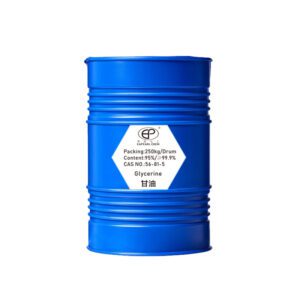Look no further because, in this article, we’re diving deep into the world of this fascinating compound.
Dipropylene glycol, often abbreviated as DPG, is a versatile chemical that serves numerous purposes across various industries. This compound has proven indispensable for personal care products and pharmaceuticals, even as a fragrance oil solvent. But how does it work?
At its core, dipropylene glycol is a type of glycol ether, which means it possesses unique properties that make it an effective solvent and stabilizer. Its low volatility and high boiling point enable it to dissolve various substances, making it a popular choice for seamlessly blending different ingredients.
Furthermore, propylene glycol’s hydrophilic and lipophilic nature contributes to its ability to solubilize both water-soluble and oil-soluble compounds, allowing for the optimal formulation of countless products.
Knowing the science behind dipropylene glycol is essential in understanding its importance in the industries it serves. So, join us as we unlock the secrets of this versatile compound and explore its significance in our everyday lives.
Chemical properties and composition of DPG
Dipropylene glycol (DPG) is a clear, colorless liquid with a molecular formula of C6H14O3. It belongs to the chemical class of glycol ethers, organic compounds containing both an alcohol and an ether functional group. The structure of DPG consists of two propylene glycol units connected by an ether bond.
DPG has a relatively low vapor pressure and high boiling point, which makes it a stable compound with a wide range of applications. Its chemical properties, including its solubility in water and organic solvents, make it an excellent solvent and carrier agent for various substances.
Industrial applications of DPG
DPG finds applications in numerous industries due to its unique properties and versatility. Let’s explore some of the critical industrial uses of this compound.
DPG as a solvent and carrier agent
One of the primary uses of DPG is as a solvent and carrier agent. Its ability to dissolve both water-soluble and oil-soluble compounds makes it an ideal choice for formulating a wide range of products. DPG is commonly used in paints, coatings, adhesives, and cleaning products.
In the paint industry, DPG is a solvent that helps dissolve and disperse pigments, binders, and other additives. It enhances the flow and leveling of the paint, resulting in a smooth and even finish. DPG’s low volatility allows it to evaporate slowly, providing sufficient drying time for the color to cure correctly.
DPG in the cosmetics and personal care industry
The cosmetics and personal care industry extensively utilizes DPG due to its excellent solubilizing properties and mild nature. DPG is often found in lotions, creams, shampoos, and deodorants.
In skincare products, DPG acts as a humectant, helping to retain moisture and prevent dryness. It also functions as a solvent for active ingredients, ensuring their effective delivery into the skin. DPG’s low toxicity and compatibility with other elements make it a preferred choice for formulators.
DPG in the fragrance industry
Dipropylene glycol plays a crucial role in the fragrance industry as a solvent for fragrance oils. It helps dissolve and stabilize the aromatic compounds, allowing for a consistent and long-lasting scent.
Due to its low odor and ability to blend well with other ingredients, DPG is commonly used as a carrier agent for perfumes, colognes, and other fragrance products. It ensures the fragrance remains stable and retains its desired characteristics over time.
DPG in the pharmaceutical industry
DPG serves various purposes in the pharmaceutical industry, including as a solvent for active pharmaceutical ingredients (APIs) and a co-solvent in injectable formulations.
DPG’s ability to solubilize both hydrophilic and lipophilic compounds makes it an excellent choice for enhancing the bioavailability of poorly soluble drugs. It also acts as a stabilizer, preventing the degradation of sensitive pharmaceutical ingredients.
DPG as a solvent and carrier agent
While dipropylene glycol is generally considered safe for use in the industries it serves, certain precautions should be taken to ensure its secure handling and usage.
Following the recommended guidelines and regulations regarding the storage, transportation, and disposal of DPG is essential. Protective measures, such as wearing gloves and goggles, should be implemented when handling DPG in concentrated form. Adequate ventilation is also necessary to minimize exposure to vapors.
Additionally, regulatory bodies such as the Environmental Protection Agency (EPA) and the Food and Drug Administration (FDA) have established guidelines and limits for DPG usage in specific applications. Manufacturers and formulators must comply with these regulations to ensure the safety of consumers and the environment.
DPG in the cosmetics and personal care industry
While DPG offers many advantages, alternatives are available for specific applications with certain limitations.
For instance, propylene glycol (PG) is often used as a substitute for DPG in specific formulations. PG shares similar properties with DPG but has a lower boiling point, which may limit its use in applications requiring higher temperatures. Other glycol ethers, such as ethylene glycol monobutyl ether (EGBE) and triethylene glycol dimethyl ether (TriEGDME), also find applications as solvents but may have different solubility characteristics compared to DPG.
Formulators and manufacturers must consider the specific requirements of their products and select the appropriate alternative based on performance, safety, and regulatory compliance.
DPG in the fragrance industry
Dipropylene glycol plays a vital role in numerous industries thanks to its unique properties and versatility as a solvent and carrier agent. As technology and research advance, there is potential for further advancements in DPG formulations and applications.
Research efforts are focused on developing sustainable and environmentally friendly alternatives to traditional solvents, including DPG. The future may bring innovations that further enhance the performance and safety of DPG-based products, ensuring their continued relevance in the ever-evolving industrial landscape.
In conclusion, understanding the science behind dipropylene glycol is essential in appreciating its significance in various industries. Its ability to solubilize, stabilize, and blend different substances makes it an indispensable compound for formulators and manufacturers. As we continue to explore the possibilities of DPG, we uncover new opportunities for innovation and improvement in the products we use every day.
For more information and insights into the science behind dipropylene glycol, stay tuned for future articles and research in this fascinating field.
DPG in the pharmaceutical industry
The fragrance industry heavily relies on dipropylene glycol as a solvent for fragrance oils. The ability of DPG to dissolve and stabilize these oils is crucial in producing perfumes, colognes, and scented products. When combined with fragrance oils, DPG helps to enhance the longevity and diffusion of the scent, allowing it to linger on the skin or in the air for an extended period.
In addition to its solvent properties, dipropylene glycol also acts as a carrier for fragrance oils. It helps to distribute the scent evenly throughout a formulation, ensuring a consistent fragrance experience for the end consumer. This makes DPG an essential ingredient in creating complex perfume blends, where multiple fragrance components must be harmoniously combined.
Moreover, dipropylene glycol’s low odor and colorlessness make it an ideal choice for fragrance applications. It doesn’t interfere with the aromatic profile of the fragrance oils, allowing the true scent to shine through. This versatility and compatibility with a wide range of fragrances have cemented DPG’s position as a staple in the fragrance industry.
Safety considerations and regulations for DPG usage
Beyond the fragrance industry, dipropylene glycol is vital in the pharmaceutical sector. Its properties as a solvent and stabilizer make it an excellent choice for drug formulation and delivery systems. DPG can solubilize active pharmaceutical ingredients (APIs) poorly soluble in water or other solvents, enhancing their bioavailability and therapeutic efficacy.
Furthermore, dipropylene glycol’s ability to solubilize hydrophilic and lipophilic compounds makes it suitable for formulating a wide range of pharmaceutical products. It can be used in oral solutions, suspensions, creams, and gels, enabling the efficient delivery of medications in various forms. The low toxicity and relatively low cost of DPG also contribute to its popularity in the pharmaceutical industry.
In addition to its role as a solvent, dipropylene glycol can act as a stabilizer in pharmaceutical formulations. It helps prevent degradation and maintain the stability of active ingredients, ensuring the potency and effectiveness of the medication over time. This is particularly crucial for drugs sensitive to environmental factors such as light, heat, or moisture.
Alternatives to DPG and their limitations
While dipropylene glycol offers numerous benefits, it is essential to consider safety considerations and adhere to regulations when using this compound. As with any chemical, proper handling, storage, and disposal procedures are crucial to ensure the safety of both the users and the environment.
Dipropylene glycol is considered safe for cosmetic and personal care products within the recommended concentration limits. However, it is always recommended to conduct thorough safety assessments and tests before incorporating DPG into any formulation. This ensures compliance with regulatory guidelines and guarantees the safety of consumers.
It is worth noting that some individuals may be sensitive to dipropylene glycol and may experience skin irritation or allergic reactions. Therefore, it is essential to conduct patch tests and monitor for any adverse effects when using products containing DPG, especially on sensitive skin or for individuals with known sensitivities.
Regulatory bodies, such as the FDA and the European Chemicals Agency (ECHA), have established guidelines and restrictions on the usage of dipropylene glycol in different industries. These regulations protect human health and the environment by ensuring safe handling, labeling, and disposal practices. Adhering to these regulations is crucial to maintaining industry standards and upholding the safety of consumers.
Conclusion: The future of DPG and its potential advancements
While dipropylene glycol offers numerous benefits, alternative compounds can serve similar purposes in various industries. Propylene glycol (PG) and tripropylene glycol (TPG) are two common alternatives to DPG.
Propylene glycol is similar to dipropylene glycol and is often used as a substitute in specific applications. However, it has a higher volatility and lower boiling point than DPG, which may limit its suitability in particular formulations. Additionally, dipropylene glycol’s solvency power may be less robust than propylene glycol, making it less effective in specific applications.
Tripropylene glycol, on the other hand, has a higher molecular weight and boiling point than dipropylene glycol. While it exhibits similar solvent properties, these differences may affect its compatibility with specific ingredients or formulations. The choice between DPG, PG, or TPG ultimately depends on each application’s specific needs and requirements.
It is essential to consider the limitations and characteristics of alternative compounds when determining the most suitable option for a particular formulation. Thorough evaluation and testing should be conducted to ensure the desired performance and stability of the final product.








